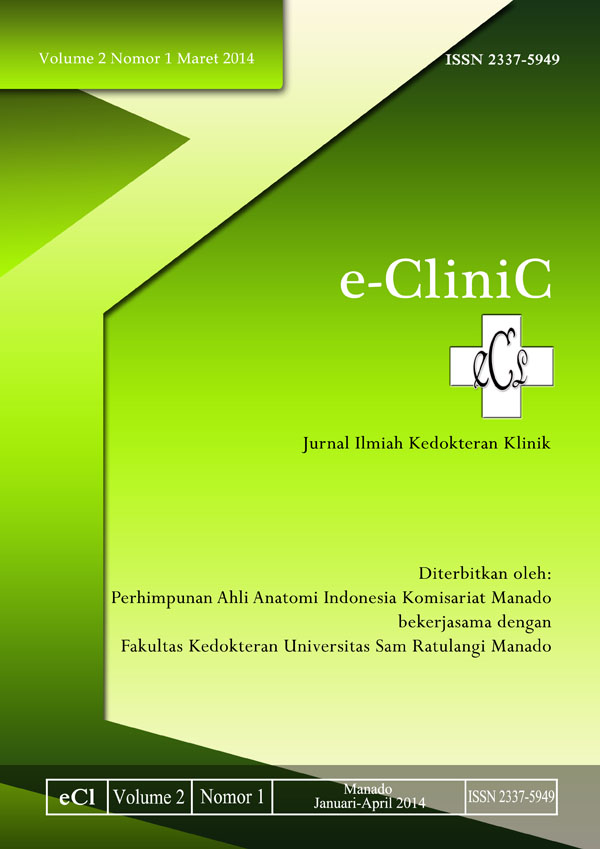GAMBARAN DISFUNGSI EREKSI DAN HUBUNGAN DIABETES MELITUS DAN HIPERTENSI TERHADAP KEJADIAN DISFUNGSI EREKSI PADA PENDERITA STROKE DI POLI NEUROLOGI RSUP PROF. DR. R. D. KANDOU MANADO
DOI:
https://doi.org/10.35790/ecl.v2i1.3605Abstract
ABSTRACT: Stroke is a big health problem in all industrial nations. In Indonesia, the prevalence of stroke keeps on increasing with each passing year. In addition to physical complaints suffered, sexual function may affect the patient’s. Erectile dysfunction is a problem that often arises in stroke patients. Purpose: This research is aimed in understanding describe of erectile dysfunction and the relationship between the risk factor namely diabetes mellitus and hypertension among stroke patients. Methods: The research method used is analytic descriptive with cross sectional approach. The study subjects were 40 men stroke patients, recruited by consecutive sampling in Polyclinic Neurology RSUP Prof. Dr. R. D. Kandou Manado during the period of November to December 2013. The measurement of erectile dysfunction used International Index of Erectile function/IIEF-5. Conclusion: Stroke patients who experience erectile dysfunction by 85%, with the highest amount on mild erectile dysfunction and mild to moderate erectile dysfunction at 35% dan 32,5%. Age most experienced erectile dysfunction are in the age group 35-44 years and >75 years. Low levels of education may suffer from erectile dysfunction is higher than the high education level. And the insiden of erectile dysfunction among stroke patients having risk factor of diabetes mellitus were higher than haven’t (OR=2,391). While hypertension risk factors correlated with a reduced risk of disease (OR=0,771).
Keywords: Stroke, erectile dysfunction, diabetes mellitus, hypertension
Â
Â
ABSTRAK: Stroke merupakan masalah kesehatan yang besar di negara-negara industri, prevalensi stroke di Indonesia terus meningkat dari tahun ke tahun. Selain keluhan fisik yang diderita, keadaan fungsi seksual dapat mempengaruhi penderita. Disfungsi ereksi merupakan masalah yang sering timbul pada pasien stroke. Tujuan: Penelitian ini bertujuan untuk mengetahui gambaran disfungsi ereksi dan hubungan diabetes melitus dan hipertensi terhadap kejadian disfungsi ereksi pada pasien stroke. Metode: Jenis penelitian yang digunakan adalah deskriptif analitik dengan pendekatan cross sectional. Jumlah sampel sebanyak 40 pasien stroke laki-laki yang diambil secara consecutive sampling di Poliklinik Neurologi RSUP Prof. Dr. R. D. Kandou Manado selama bulan November - Desember 2013. Pengukuran disfungsi ereksi menggunakan International Index of Erectile Function/IIEF-5. Simpulan: Pasien stroke yang mengalami disfungsi ereksi sebesar 85% dengan jumlah terbanyak pada disfungsi ereksi ringan dan disfungsi ereksi ringan sampai sedang sebesar 35% dan 32,5%. Umur terbanyak mengalami disfungsi ereksi terletak pada kelompok umur 35-44 tahun dan >75 tahun. Tingkat pendidikan rendah dapat mengalami disfungsi ereksi lebih tinggi daripada yang tingkat pendidikannya tinggi. Dan insiden disfungsi ereksi diantara pasien stroke yang mempunyai faktor resiko diabetes melitus adalah lebih tinggi daripada yang tidak mempunyai faktor resiko tersebut (OR=2,391). Sedangkan faktor resiko hipertensi berkorelasi dengan berkurangnya resiko penyakit (OR=0,771).
Kata Kunci: Stroke, disfungsi ereksi, diabetes melitus, hipertensi
Downloads
How to Cite
Issue
Section
License
COPYRIGHT
Authors who publish with this journal agree to the following terms:
Authors hold their copyright and grant this journal the privilege of first publication, with the work simultaneously licensed under a Creative Commons Attribution License that permits others to impart the work with an acknowledgment of the work's origin and initial publication by this journal.
Authors can enter into separate or additional contractual arrangements for the non-exclusive distribution of the journal's published version of the work (for example, post it to an institutional repository or publish it in a book), with an acknowledgment of its underlying publication in this journal.
Authors are permitted and encouraged to post their work online (for example, in institutional repositories or on their website) as it can lead to productive exchanges, as well as earlier and greater citation of the published work (See The Effect of Open Access).







